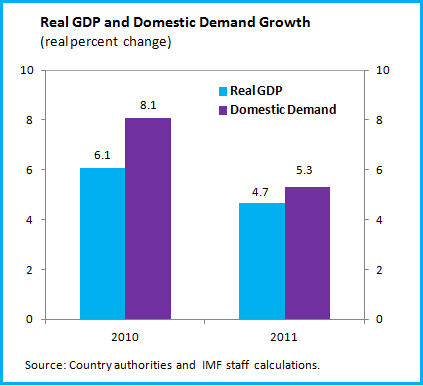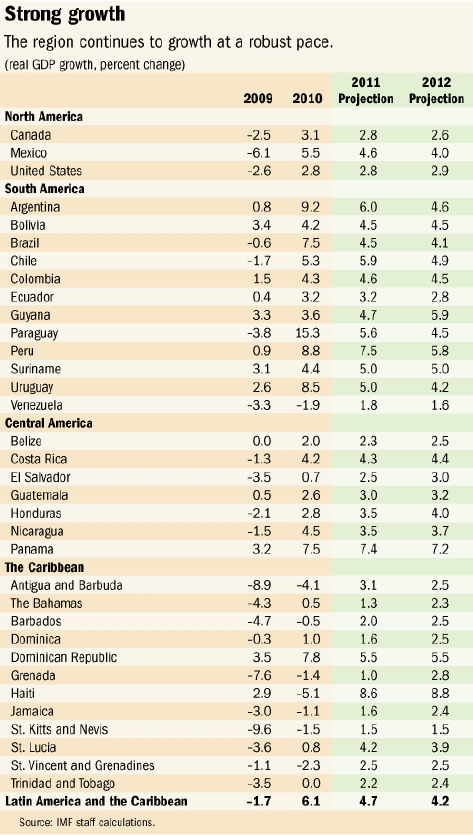
Typical street scene in Santa Ana, El Salvador. (Photo: iStock)
IMF Survey: Watching Out for Overheating in Latin America
May 3, 2011
- Growth is moderating, yet still remains above potential
- Overheating pressures emerging in much of the region, including inflation worries
- Higher fuel and food prices adding to challenges
Economic growth in much of Latin America remains strong, propelled by rising commodity prices, easy financing conditions, and stimulative policies. Growth exceeded 6 percent in 2010, and while it is projected to moderate to about 4¾ percent in 2011, the IMF says countries should remove the policy stimulus on a timely basis.

Market vendor in Montevideo, Uruguay. The IMF warns inflationary pressures are emerging in Latin America (photo: Per Karlsson/Newscom)
Regional Economic Outlook
In its Regional Economic Outlook for the region, issued on May 3 in Mexico City, Mexico, the IMF said that the region continues to grow at a robust pace, led by rapidly expanding domestic demand.
“The main economic risk in the case of Latin America is complacency,” said Nicolás Eyzaguirre, head of the IMF’s Western Hemisphere Department, in a video interview. “The region is growing a bit beyond its possibilities so if it does not begin to put the brakes on and continues at this pace, economies could eventually overheat,” he added.

For the Unites States, the near-term outlook for growth has become somewhat more favorable, although new risks have emerged. A sharp and prolonged increase in oil prices could significantly slow the U.S. and global recovery. In addition, the report states that the medium-term budgetary outlook remains troublesome and there is a need to reach early political consensus on a comprehensive and balanced fiscal consolidation plan.
Within Latin America and the Caribbean, economic performance will be less uneven in 2011. South America’s commodity exporters will continue to lead the expansion, though there are signs that the recovery is finally gaining some traction in economies with closer real links to advanced economies (Central America and the Caribbean), where recovery has lagged.
Overheating risks
According to the report, overheating risks stand out in much of Latin America. Growth remains above trend and domestic demand has been growing even faster, pushed not only by unprecedented favorable external conditions but also by economic policies that have been quite stimulative and are only gradually normalizing. Early signs of overheating pressures and possible excesses are appearing in several areas:
• Inflation is rising in much of the region. Many central banks have been raising interest rates, but more rate hikes will be needed to contain demand pressures and limit spillovers from higher food and fuel prices into core inflation and expectations.
• Current account deficits are widening in many countries. Even in those benefitting from higher commodity export prices, import growth has been outpacing exports. While current account deficits are not yet excessive, their movement in that direction will need to slow. Fiscal policy can contribute in this regard, particularly through slowing the growth in public expenditure.
• Credit is accelerating in many countries. While banking systems seem to remain sound, vigilance is needed as leverage and external exposure is increasing in some countries.
• External borrowing by corporations is up and some assets are looking pricy. Countries should continue to adopt and strengthen prudential policies, although these cannot substitute for having suitable monetary and fiscal policies in place.
A summary of policies to manage the current bonanza is also discussed in greater detail in the paper, Managing Abundance to Avoid a Bust in Latin America.
Rebuilding policy buffers
Countries in Central America and the Caribbean experiencing weaker growth will also need to proceed carefully, the report warned. These countries should focus on rebuilding the policy buffers used during the recent global recession to better prepare themselves in case of another shock. In Central America, where output gaps are closing, priorities should shift towards strengthening the business climate and institutions, which are known to be weak.
In much of the Caribbean, where public debt is very high, fiscal policy will need to continue consolidating to ensure economic stability and set the stage for higher and more sustainable growth in the future.
Protecting the poor from rising commodity prices
Rising global prices of commodities, especially food, pose an important social challenge across the region. This applies even to countries that are net exporters of commodities and food, the report said.
To protect the poor, policies should focus on scaling up proven social safety net programs, such as targeted income transfers, school lunches, and child nutrition programs. Generalized price subsidies should be avoided as these measures are often very costly and regressive, and can turn out to be permanent—requiring large adjustments to other parts of the budget. The expansion of safety nets should take place within the established budget envelope, in some cases to avoid stimulating demand (South America), while in other cases to rebuild the policy buffers (Central America and the Caribbean).



